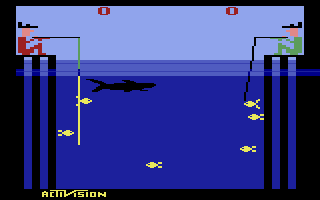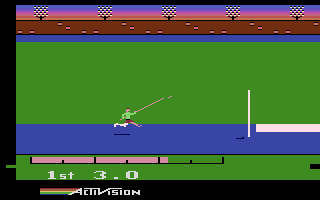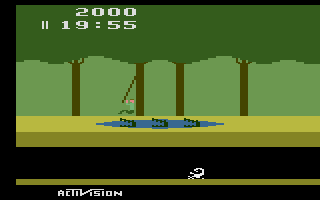 Some of my fondest memories of youth involve playing Atari for hours on the
hottest summer days. Most of the neighborhood youths were outside playing
baseball or swimming, while indoors, in a dark room powered by an
air-conditioner turned all the way up, my best friend Kevin and I – two
social misfits – talked trash while reeling a five-point fish past a pesky
shark.
Some of my fondest memories of youth involve playing Atari for hours on the
hottest summer days. Most of the neighborhood youths were outside playing
baseball or swimming, while indoors, in a dark room powered by an
air-conditioner turned all the way up, my best friend Kevin and I – two
social misfits – talked trash while reeling a five-point fish past a pesky
shark.
If any programmer pushed the Atari 2600 to it’s limits, it would have to have been David Crane. Crane was one of the key designers with Activision from the time of its inception to its final days producing software for the system. Crane designed Dragster, Fishing Derby, Laser Blast, Freeway, Grand Prix, Decathlon, Pitfall!, Pitfall II, and Ghostbusters while at Activision, as well as Canyon Bomber, Slot Machine, and Outlaw in the "pre-third-party" era.
You might find this strange, but my favorite David Crane game is Fishing Derby, one of his first for Activision. In the game, you go head-to-head against another fisherman as you try to reel in 99 points worth of smelly fish. Spoiling the day is a shark who patrols the water near the surface and will gobble up fish on your hook if he touches it. The fish range in point values, with higher points awarded the deeper you catch them.
The game appears tranquil enough, and certainly the sport isn’t going to produce any athletes (except maybe in the 12-oz arm bend competition), but the Atari 2600 version of fishing is absolutely frantic. The fish move about randomly and it takes some practice to get the hang of catching them. Once you do, you have the other player to contend with. The computer is an adequate player, but get someone in there who knows how to play the game and you’ll find this Fishing Derby to be as fast-paced and furious as any video game can get.
 If
you’ve never developed the callus on your thumbs that most of us veteran
gamers have earned, there’s no better place to start than with Crane’s
The Activision Decathlon. Wrapped up in one cartridge is the 100 meter
dash, long jump, shot put, high jump, 400 meter dash, 110 meter hurdles,
discus, javelin, 1500 meter race, and pole vault. That’s TEN different
games! You can choose to play any of these or compete with as many as four
players in the decathlon, which cycles through all of the events and keeps
score on your progress.
If
you’ve never developed the callus on your thumbs that most of us veteran
gamers have earned, there’s no better place to start than with Crane’s
The Activision Decathlon. Wrapped up in one cartridge is the 100 meter
dash, long jump, shot put, high jump, 400 meter dash, 110 meter hurdles,
discus, javelin, 1500 meter race, and pole vault. That’s TEN different
games! You can choose to play any of these or compete with as many as four
players in the decathlon, which cycles through all of the events and keeps
score on your progress.
The game has brilliant graphics, the background is a fairly believable arena setting, complete with crowd and lighting towers. There’s even an opening ceremony. The downside to the game is that all of the events require a building-up of speed by jamming your joystick left and right as rapidly as possible. We lost a few joysticks to this game as a result, but the feeling of competition we got while playing made it all seem worth losing a $10 stick.
 Probably
the most popular David Crane game is still being updated on modern systems
today. When Pitfall was released in 1982 it was way ahead of anything
that had been done on the Atari 2600 at the time. This action-exploration
game featured a huge environment (well, it was a clever trick, anyway) and
many different obstacles. Before Pitfall, we jumped over rolling
barrels. Pitfall gave us rolling logs, but also snakes, campfires,
alligators, swamps, scorpions, bottomless pits, and opening and closing
pits. All in pursuit of the mighty dollar. It was the first game I can ever
remember having to draw a map for! And as good as Pitfall was, Crane
really outdid himself with Pitfall II in 1984, which is still an
amazing game to witness on such limited hardware.
Probably
the most popular David Crane game is still being updated on modern systems
today. When Pitfall was released in 1982 it was way ahead of anything
that had been done on the Atari 2600 at the time. This action-exploration
game featured a huge environment (well, it was a clever trick, anyway) and
many different obstacles. Before Pitfall, we jumped over rolling
barrels. Pitfall gave us rolling logs, but also snakes, campfires,
alligators, swamps, scorpions, bottomless pits, and opening and closing
pits. All in pursuit of the mighty dollar. It was the first game I can ever
remember having to draw a map for! And as good as Pitfall was, Crane
really outdid himself with Pitfall II in 1984, which is still an
amazing game to witness on such limited hardware.
Ah, the days of the Atari 2600. When done right, magic was made.